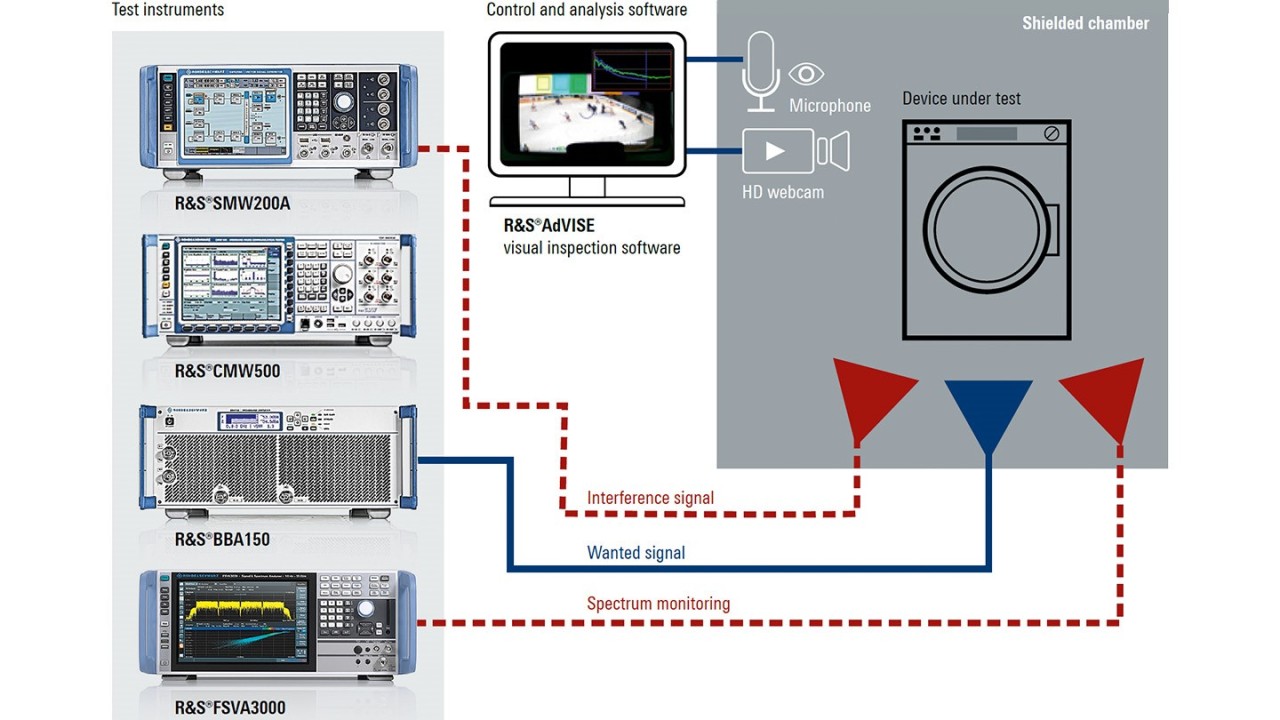Ensuring performance of connected home electronic products
Wireless coexistence testing

Wireless coexistence testing
The title of Bob Dylan’s 1964 hit “The Times They Are A-Changin’” certainly holds true for home appliance products. The consumer electronic industry needs to evolve and keep pace with the growing appetite of its customers and play a part in enabling the dream of a truly connected world. The internet of things (IoT) trend has finally reached our homes. It has enabled us to remotely access and control any object from any part of the world as long as it is connected to the internet. Wireless speaker systems, thermostats, home security and monitoring systems, domestic robots, smoke/CO detectors, lighting, home energy consumption monitors, door locks, refrigerators, laundry machines and water detectors – all these products now come with an integrated wireless communication module that supports some form of WLAN, LPWAN or Bluetooth® technology.
(The Bluetooth® word mark and logos are registered trademarks owned by Bluetooth® SIG, Inc. and any use of such marks by Rohde & Schwarz is under license)
The additional connectivity features bring new challenges and compliance requirements. Products failing to satisfy regulatory requirements could incur hefty fines and in some countries even be subjected to a stop sale order. Almost all new connected products come with a display, speaker systems and app support for easier user interaction. This gives rise to a new set of security, functionality and quality assurance challenges. Connectivity technologies (WLAN, Bluetooth®, etc.) mostly operate in the 2.4 GHz ISM band. Other connected systems located in the vicinity of the receiver may sometimes transmit on overlapping frequencies, which degrades receiver performance. This is what is known in the RF industry as the wireless coexistence problem. Coexistence issues degrade the user experience, and since non-tech users do not understand the source of the problem, they blame the product instead. This results in brand defamation.
Testing coexistence and user experience to ensure high quality of service in real-world use, and ensuring security and product compliance for risk free market introduction. The intended use case for the device under test (DUT) needs to be defined in order to identify the baseline EM environment and the corresponding functional performance of the wanted communications system. Based on the information, it is possible to define the worst-case RF scenario and later recreate it for testing. Let us consider a smart washing machine that is connected to a WLAN network. According to its intended use case, it is normally located in an area where the EM environment is mostly time invariant and stable. The worst-case scenario occurs when the washing machine is located in an area with a very weak WLAN signal and a smartphone running an active Wi-Fi hotspot and Bluetooth® application and transmitting at maximum power is placed on top of or next to the washing machine.
What happens if a smartwatch is brought into the equation? The test challenge is to recreate this exact EM environment and test conditions inside an anechoic chamber in a repeatable manner.
The DUT is placed in a large semi-anechoic chamber. The antenna of the R&S®CMW500 is pointed directly towards the antenna integrated into the DUT. The R&S®CMW500 radio communication tester is used to establish an active end-to-end connection with the DUT by emulating a noncellular network (such as Bluetooth® or WLAN) and, if required, cellular networks (such as 3G/4G networks). The R&S®BBA150 high power amplifier is optionally used to boost the signal level during radiated testing. A baseline functional performance test is performed and the results for all the relevant KPIs (such as throughput data rate, PER, BLER, video and audio performance) are recorded. In the next iteration, the power level of the wanted signal is reduced to the cell edge condition to replicate the worstcase scenario and the interference signal is introduced using the R&S®SMW200A. The R&S®SMW200A vector signal generator is used to generate realistic wideband modulated EM interference signals. The type of interference signal used for coexistence testing is a highly debated subject. The R&S®SMW200A is an extremely powerful instrument that can generate any type of signal at any frequency on the fly. The functional performance indicated by the results at this point will show the divergence from the baseline results. While performing coexistence testing, it is important to monitor the RF spectrum. This is listed as a mandatory step in most standards. The R&S®FSVA3000 signal and spectrum analyzer is used in this test system to monitor the RF spectrum. These days, most home automation products come preloaded with a display screen and a built-in loudspeaker system. These two features help the users interact with the product. It is therefore extremely important to test the application level functional performance in the presence of interference. The DUT can stream video and audio from the streaming server of the R&S®CMW500 over the WLAN link. The R&S®AdVISE software will perform real-time picture and sound quality analysis. R&S®AdVISE is a truly unique software product that uses any USB based HD webcam and microphone to collect live data in order to monitor the audio and video performance of the DUT in real time. Fault events are automatically recorded and documented in the test report.
Rohde & Schwarz is a one-stop shop catering to all wireless RF coexistence test and measurement requirements. We manufacture high-end test and measurement systems based on our long-term, vast competence in the field of wireless coexistence testing.

